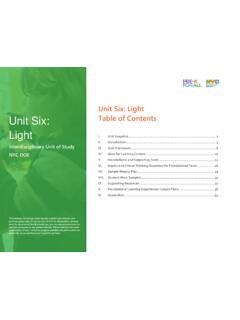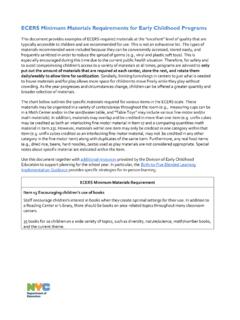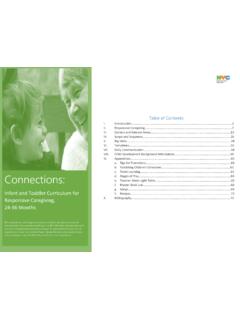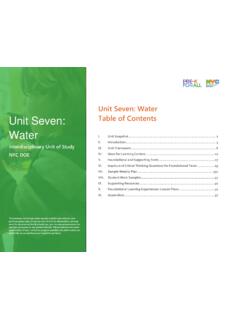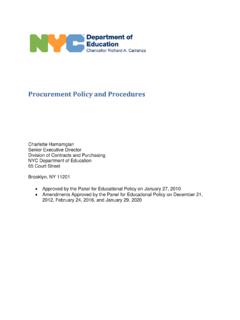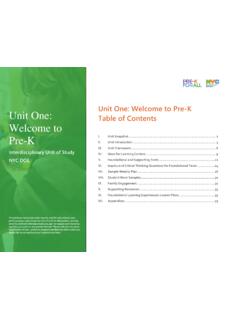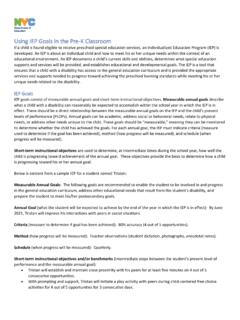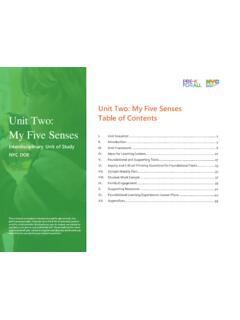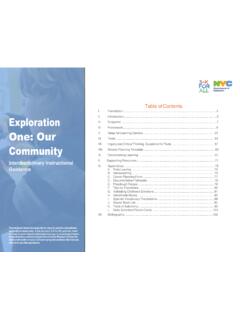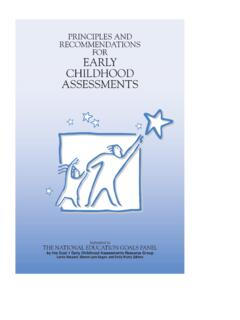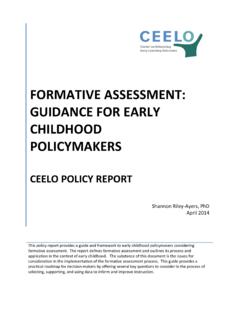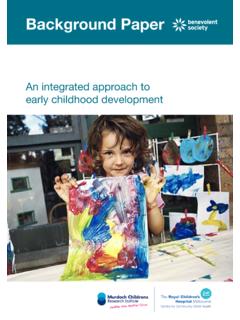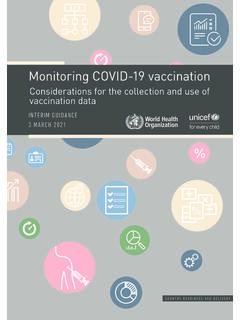Transcription of Early Childhood Environmental Rating Scale (ECERS-R) 107
1 Early Childhood Environmental Rating Scale (ECERS-R) 107 Part 1: Interpreting your ECERS-R ReportPart 2: Using the Planning TemplateECERS-R 107 Objectives Learn how to read and interpret an ECERS-R report Review ECERS-R scoring Become familiar with the new recommendations section and how to use it Learn how to determine and organize some next steps for your programHow the DECE uses ECERS-R data As one of many data points to differentiate support As one of many data points in understanding program quality for accountability purposes ( , contract renewals for DOE contracted NYCEECs) Not used in any evaluation of any staff member Leaders collaborate with their staff and families to evaluate and improve classroom and program quality, relying on well-managed data to set instructional, family engagement, and organizational goals, increasing the coherence of policies and practices.
2 ECERS-R Data and the PQS: Program ExpectationsPQS 14: Program Quality Improvement Leaders ensure that plans for improvement are evidence-based through the effective collection and management of various types and sources of data at the child, teacher, classroom and program levels (for example: attendance, authentic assessments, surveys, ECERS-R, CLASS, etc.). PQS 14A: Program Quality Improvement ECERS-R 101 Recap: How the ECERS-R is ScoredScoring starts at 1. Score is determined once an indicator is not met. What s Inside Your ECERS-R Report Your ECERS-R report provides information about the quality of the learning environment in your program Share the results with your pre-K staff to build shared investment and understanding of the resultsReport recommendations Created in response to your feedback Summarize practices that affect scoring on multiple items ( , interactions)
3 Reflect situations that programs commonly score low on Focus on implementable changes Provide a starting point for program leaders to have conversations with pre-K staff and refine program goalsPart 1A closer look at an ECERS-R ReportPage 1 Date of assessment , time that the evaluator observedHow the ECERS-R relates to the Pre-K Program Quality Standards and a description of each ECERS-R subscale Page 2Yo u r program s subscale level scores, with NYC DOE averagesYo u r program s scores on all 37 itemsPage 3 Information on: How the ECERS-R is scored How the assessment was conducted How to read the reportPage 4: RecommendationsRecommendations Section SubscaleSubscale description and connection to the PQSItem scores with citywide averagesPage 5 Onward: Information for Each SubscalePage 5 Onward: Item(s) of StrengthItem number, name, and your scorePage 5 Onward: Items scored below 5 Indicator that was not metInformation about the indicatorWhat was observed.
4 Explains why credit was not givenHow the ECERS-R is scored The report contains information about the indicator that was scored unfavorably This is so you can understand what happened during the observation and what the scores are based onInadequate12 Minimal34 Good56 Excellent7 Staff donot talk about logical relationships Concepts are introducedinappropriately Staff sometimestalk about logical relationships or concepts Someconcepts are words and concrete examples : Staff talkabout logical relationships while children play with materials Children encouragedto explain reasoning when solving problems Staff encourage children to reason using actual events and experiences Conceptsare introduced in response to children s interests or needs* This table is an abridged version of item 17 in the ECERS-R Scale Classroom schedule on day of observationAppendixItems that have time requirements, and when those materials were accessible to childrenLast two pages of reportPart 2 How to interpret an ECERS-R report and use the Planning TemplateInterpreting your ECERS-R reportPQS Connection.
5 Program Quality Improvement Leaders collaborate with program staff to regularly analyze data, providing the program with an accurate representation of the program s strengths and challenges and ensuring that conclusions are arrived at systematically and equitably. Read through reportCelebrate areas of strength!Read recommendations againOrganize items scored below 5 Choose some next steps Organizing items scored below 5 How to use the planning reasons for the these items into one of three categories: Short term goal/task Medium term goal Long-term next stepsPlanning TemplateItems scored below 5 ArtLet s look at the report, keeping the following in reasons for the Is this a short-term, mid-term, or not feasible goal?3. What are some next steps that could be taken?Items scored below 5 Art Let s look at the report, keeping the following in reasons for the this a short-term, mid-term, or not feasible goal?
6 Are some next steps that could be taken?How the ECERS-R is scoredInadequate12 Minimal34 Good56 Excellent7 Artactivities are rarely available No individual expression in activities Some art materials available for at least 47 minutes individual expression allowed : Many and varied art materials accessible for 1/3of day Muchindividual expression in use of art materials 3 Dart materials included monthly Some art activities relatedto learning units Provisions made for children to extend projects over multiple daysAbridged version of item 20, Art in the ECERS-R Scale Items scored below 5 reasons for the score. Not enough materials: missing from either the 3-D category or the paint category Not enough this a short-term, mid-term, or not feasible goal? Materials: short-term Time: are some next steps that could be taken? Decide what materials to add Decide if any materials should be removed Take inventory of art center supplies across classrooms Order materials, or collect recyclable collage materials from families or local businessesItems scored below 5 Music and MovementLet s look at another reasons for the this a short-term, mid-term, or not feasible goal?
7 Are some next steps that could be taken?Items scored below 5 Music and reasons for the score. There was a bin with various instruments and enough for all the children in the classroom, and also a CD player; however, these were located on a high shelf out of reach of children. this a short-term, mid-term, or not feasible goal? are some next steps that could be taken? Create a music center and put materials at a height accessible to children; or Take basket of musical instruments to the gross motor space Items scored below 5 Language ReasoningLet s review Language-Reasoning item 17 reasons for the this a short-term, mid-term, or not feasible goal? are some next steps that could be taken?Items scored below 5 Language reasons for the score. There were no instances of children being encouraged to talk through or explain their reasoning when solving this a short-term, mid-term, or not feasible goal?
8 Are some next steps that could be taken? If you re not sure: turn to the All About the ECERS-R book or your instructional coordinator or social worker for more information Review DECE s Interdisciplinary Units online for sentence starters for each center Observe and look for examples of staff encouraging children to talk throughout the day Adjust or try another strategy if that one doesn t workAll time related items 11 items require that children have time to play with materials for at least 1/3 of the day (2 hours, 7 minutes) Sometimes there are structural challenges to making this happen ( , larger school schedule) Look at the appendix to find out more about how time was actually spent on the day of the assessmentLast page of report All time related items Second to Last Page -ScheduleMeeting higher-level play requirements reasons for the score. Not enough time for children to this a short-term, mid-term, or not feasible goal?
9 Are some next steps that could be taken? Review schedule to determine how time is spent Look for times when a lot of time is spent on transitions Discuss and identify strategies for minimizing transitions Try strategy to see if it works, paying attention to the time that it takes Adjust or try another strategy if that one doesn t work Look at other times in the day to determine if small transitions could be eliminated, too. Review the DECE s Tools of Autonomy document for suggestions ECERS-R Webinar Series TitleDescriptionECERS-R 101 Why theDECE uses the ECERS-R tool What the ECERS-R tool measures, broadly What to expect before, during,and after an ECERS-R assessment What resources are available to support youECERS-R 102 This webinar provides a deep dive into the Space and Furnishings subscaleECERS-R 103 This webinar provides a deep dive into the Personal Care RoutinessubscaleECERS-R 104 This webinar provides a deep dive into the Language-Reasoningand Interaction 105 This webinar provides a deep dive into the 106 This webinar provides a deep dive into the Program StructuresubscaleECERS-R 107 How to read and interpret your ECERS-R report How to use ECERS-Rdata andrecommendations toinform pre-K program goalsThank you!
10 For any further questions to.
